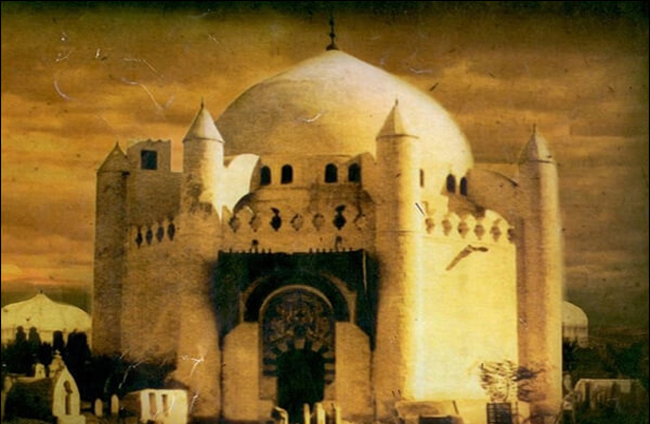-

 Know, the true nature of your Beloved.
Know, the true nature of your Beloved.
In His loving eyes, your every thought,
Word and movement is always –
Always Beautiful.
~ Hafiz
The Golden Chain

5. Shaykh Jafar as-Sadiq
Shaykh Jafar as-Sadiq (may God sanctify his innermost being) was born in 702 C.E in Medina and is the fifth Master in the Golden Chain lineage.
His geneology holds a special place in the Naqshbandi Order. His father, Imam Muhammad al-Baqir, was the son of Imam Zain al-Abidin, whose father was Husayn, whose father was Ali ibn Abu Talib. His mother’s father was al-Qasim, the fourth Shaykh in the Golden Chain, and from whom he received the secret of the Golden Chain. His grandfather was Abu Bakr as-Siddiq.
Consequently, he received from the Prophet (peace & blessings upon him) the meeting of two lines of profound spiritual inheritance: the secret of the Prophet through Ali and the secret of the Prophet through Abu Bakr. For this reason he was called ‘The Inheritor of the Prophetic Station and the Inheritor of the Truthful Station’. The lights of the knowledge of Truth and Reality were reflected through him.
The Naqshbandi Order is unique in Sufism, because it is initiated from the Prophet through Abu Bakr as-Siddiq. However, through Jafar as-Sadiq, the Shaykhs of the Golden Chain also received spiritual access to Ali ibn Abu Talib.
He took knowledge from his father through Ali and from his grandfather, al-Qasim, through Abu Bakr. Being of the generation of the Followers (Tabi’een), he then added to this knowledge by learning from the Companions of the Prophet. Jafar spent the first twelve years of his life beside his Grandfather, Zain al-Abidin and then nineteen years beside his father, whilst he was the Imam.
His lifetime spanned the rule of the last few caliphs of the Umayyad and the first two of the Abbasid dynasties. Whilst he did not overtly contest their secular leadership, he suffered from persecution by them. Despite living in a climate of tumultuous political change, the Imam was at the crest of the peak of intellectual activity of the time. The Imam clarified and resolved many controversial points; for example, he identified the answer to the conflict between free-will and compulsion, through a balanced approach. It was he who delineated the guideline of using the Quran to validate prophetic traditions: if they were in agreement, they were accepted. The depth and breadth of his knowledge of the traditions was unmatched by any of his contemporaries.
His profound spiritual inheritance and teachings attracted at least four thousand scholars that are known to have taken knowledge from him. Among these, who considered him their master, were two of the four great Imams of Islam, who created two of the four ‘Madhahib’ or ‘Paths’, or Schools of Divine Law of the Islamic religion:-
– Imam Abu Hanifa, who created the Hanifi Madhahib.
– Imam Malik, who created the Maliki Madhahib.
Consequently, Jafar’s profound effect on Islam cannot be underestimated – by Divine will, these Schools of Divine Law have traversed the centuries as the path and ‘qibla’ for the majority of Muslims.
He also taught other leading figures in Islam, such as Sufyan ath-Thawri, Sufyan bin Ayinah and al-Qattan.
He later spent his life in worship and acts of piety for the sake of God, rejecting the positions of fame offered to him. He had two sons from his first wife. Following her death, he purchased and freed an Andalusian slave named Hamidah, trained her as an Islamic scholar and then married her. She later bore him two sons and became famous for her wisdom and knowledge, being known as Hamidah the Pure.
He passed away in 765 A.D. and was buried in Jannat al-Baqi in Medina.
May God be pleased with him.
Sources:-
“The Naqshbandi Way – History and Guidebook of the Saints of the Golden Chain”, by Mawlana Shaykh Hisham.
‘The Lantern of the Path’ by Imam Jafar as-Sadiq.
‘The Four Imams and their Schools’ by Gibril Fouad Haddad.
